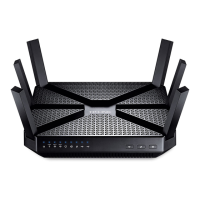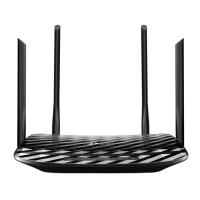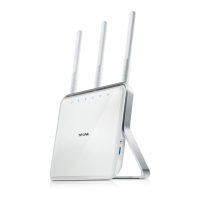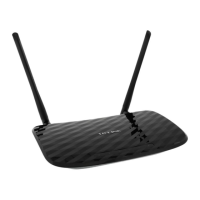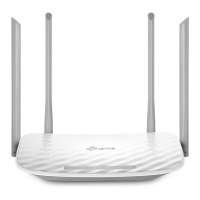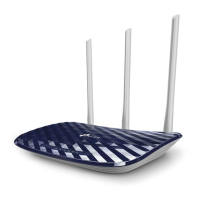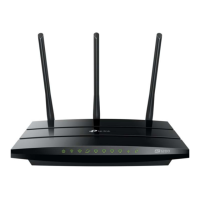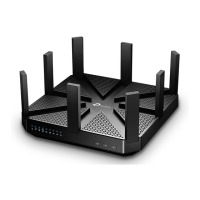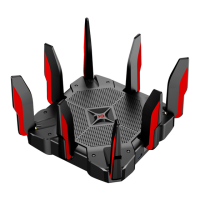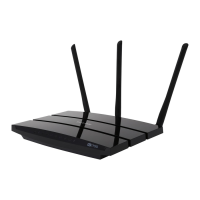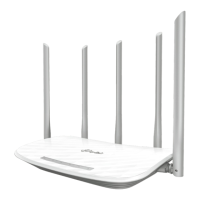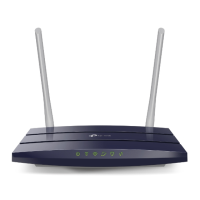Do you have a question about the TP-Link ARCHER C3150 and is the answer not in the manual?
Details the router's capabilities, speed, technology, and design for home use.
Lists key wireless and wired performance features and specifications of the router.
Step-by-step instructions for physically connecting the router to the modem and power.
Guides users through the automated process of setting up the router's internet connection.
Explains how to manually adjust internet connection settings based on ISP information.
Shares USB storage devices with network clients via Windows or Mac.
Sets limits on internet access times and specific websites for network users.
Assigns minimum/maximum bandwidth to individual computers to optimize network usage.
Configures SPI Firewall and DoS Protection to defend against cyber threats.
Blocks or allows specific devices to access the network using Blacklist or Whitelist modes.
Shares local resources like websites or FTP servers over the Internet.
Sets up OpenVPN server for secure access to the home network from remote clients.
Customizes wireless network name (SSID), password, security, and other parameters.
Uses ping and traceroute to diagnose connectivity issues between the router and other devices.
Installs the latest firmware to improve performance and features.
Saves router settings to a file and restores them, or resets to factory defaults.
Troubleshooting steps for accessing the router's web management interface.
Guides on resolving issues when the internet is not accessible after configuration.
Details the router's capabilities, speed, technology, and design for home use.
Lists key wireless and wired performance features and specifications of the router.
Step-by-step instructions for physically connecting the router to the modem and power.
Guides users through the automated process of setting up the router's internet connection.
Explains how to manually adjust internet connection settings based on ISP information.
Shares USB storage devices with network clients via Windows or Mac.
Sets limits on internet access times and specific websites for network users.
Assigns minimum/maximum bandwidth to individual computers to optimize network usage.
Configures SPI Firewall and DoS Protection to defend against cyber threats.
Blocks or allows specific devices to access the network using Blacklist or Whitelist modes.
Shares local resources like websites or FTP servers over the Internet.
Sets up OpenVPN server for secure access to the home network from remote clients.
Customizes wireless network name (SSID), password, security, and other parameters.
Uses ping and traceroute to diagnose connectivity issues between the router and other devices.
Installs the latest firmware to improve performance and features.
Saves router settings to a file and restores them, or resets to factory defaults.
Troubleshooting steps for accessing the router's web management interface.
Guides on resolving issues when the internet is not accessible after configuration.
| Modulation | 1024-QAM |
|---|---|
| Wi-Fi band | Tri-band (2.4 GHz / 5 GHz / 5 GHz) |
| Wi-Fi standards | 802.11a, Wi-Fi 5 (802.11ac), 802.11b, 802.11g, Wi-Fi 4 (802.11n) |
| Top Wi-Fi standard | Wi-Fi 5 (802.11ac) |
| WLAN data transfer rate (max) | 2167 Mbit/s |
| WLAN data transfer rate (first band) | 1000 Mbit/s |
| Certification | CE, FCC, RoHS |
| Built-in processor | Yes |
| Processor frequency | 1400 MHz |
| Memory card slot(s) | - |
| USB 2.0 ports quantity | 1 |
| Ethernet LAN (RJ-45) ports | 4 |
| Product type | Portable router |
| Product color | Black |
| SIM card slot | No |
| Networking standards | IEEE 802.11a, IEEE 802.11ac, IEEE 802.11b, IEEE 802.11g, IEEE 802.11n |
| VPN tunnels quantity | 10 |
| Ethernet LAN data rates | 10, 100, 1000 Mbit/s |
| Ethernet LAN interface type | Gigabit Ethernet |
| Security algorithms | 64-bit WEP, 128-bit WEP, IPSEC, WPA, WPA-PSK, WPA2 |
| Storage temperature (T-T) | -40 - 70 °C |
| Operating temperature (T-T) | 0 - 40 °C |
| Storage relative humidity (H-H) | 5 - 90 % |
| Operating relative humidity (H-H) | 10 - 90 % |
| Power source type | AC |
| Harmonized System (HS) code | 85176990 |
| Depth | 197.8 mm |
|---|---|
| Width | 263.8 mm |
| Height | 37.3 mm |
